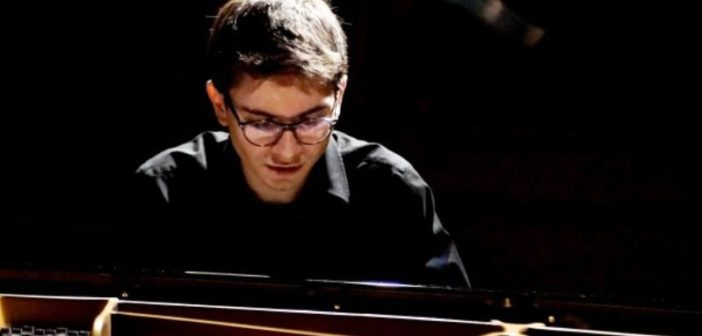The eyes and ears of the music world were focused last week on the Concours musical international de Montréal (CMIM), held under conditions no one would have imagined a year ago when the competition was cancelled because of COVID-19. We all knew the competition this year was going to be different, but how different, and how successful? The short answers are very different and, so far, highly successful.
“The positive feedback so far has been tremendous,” commented CMIM executive and artistic director Christiane LeBlanc. “The whole team and I are extremely satisfied in how things are unfolding so far. It has been a huge logistical undertaking for us, but seeing it happen, plus the positive feedback of the jury and the gratitude of the competitors, have made it all worthwhile.”
All 26 contestants were carried over from last year’s cancelled competition. They came from 11 countries, although “came” is probably the wrong word. Through a monumental effort on the part of the CMIM, the pianists pre-recorded their 45-minute semifinal recitals on video in one of 14 cities around the world: New York, Kansas City, Ann Arbor (Michigan), Montreal, London, Paris, Basel, Berlin, Biella (Italy), Seoul, Tokyo, Moscow, Vienna and Warsaw, thus bypassing the headaches, uncertainties and restrictions of international travel. Likewise, the judges were relieved of the need to travel by staying at home and watching the performances via webcast.
For obvious reasons, quality control was of the highest importance. To this end, only Steinway instruments were used. The audio and video equipment of each homebound jury member was verified by the CMIM to ensure high quality of reception. Recording teams needed to be prepped, their equipment (both audio and video) had to be assessed for standards, and camera work had to be consistent. Three cameras were used in alternation: a profile view of the pianist from a camera located front row center; a frontal view as seen from the rear of the piano, and a closeup of the keyboard and hands.
Each recital was treated as a one-time-only, live event; if anything had gone wrong, there were no second chances (none were needed). The recitals were broadcast throughout the day, spaced an hour apart (Montreal time) from April 26-30 in a sequence determined by random draw. The logistical challenges were monumental, but everything seems to have worked.
“Luckily there were no behind-the-scene crises,” reports LeBlanc, “just a lot of insomnia for the CMIM team with all those time zones! We did have to move Canadian Kevin Ahfat quickly from Toronto to Montreal when Ontario confined the province and closed the concert halls, but that was the only mishap.” Both audio and video quality were uniformly excellent, with one exception: the lighting for Ahfat in Montreal’s Maison symphonique was inadequate, though this had no effect on his performance. The CMIM’s web site could be a bit tricky to navigate, but once you learned how it worked, everything was fine.
So who were the 26 contestants? Seventeen of them – 65% ̶ were from Asia or of Asian descent (not including Russia), and of these, seven were South Korean. (Has South Korea overtaken Russia as the world’s leading generator of competition-level pianists?) One of the two Canadians and two of the three Americans were of Asian descent. There were only two Russians, and neither made it to the finals. All were born in the last decade of the last century. Youngest of all is Korean Suah Ye, born in 2000. Youngest of the eight finalists we will hear next week is the Italian Francesco Granata, born in 1998. No one attempted to make a sartorial statement this time (there have been exceptions in the past). In fact, all but one wore black, and that exception was a conservative choice too. The performance level in the semifinals was, as usual, wide, ranging from barely adequate to extremely high, but with far more contestants at the upper extreme than at the lower. I marked no fewer than eight as possible first-prize material, and many of those remaining would still qualify for one prize or another.
Another big difference in this year’s competition was allowing the competitors to choose their own repertory. The only requirements were the imposed Canadian work (three of John Burge’s 24 Preludes), to be performed only by the finalists; and, in conjunction with the Montreal Bach Festival, something by Bach in either the semi-final or final round. The norm was three or four works per semifinal recital, but some pianists programmed as many as six, while Cristian Sandrin put all his eggs in one basket by offering just Bach’s Goldberg Variations, which, when played without repeats, clocks in at about 45 minutes.
The repertory chosen revealed interesting patterns. Amazingly, of the nearly one hundred different compositions performed in the semifinals, only three – Schumann’s Humoreske, Beethoven’s Sonata Op. 10 No. 2, and Stravinsky’s Three Movements from Petrushka – were offered twice. Those favourite competition standbys like the Liszt Sonata, the Prokofiev Seventh and Rachmaninoff’s Second were heard just once each. Beethoven’s Appassionata, Balakirev’s Islamey and Mussorgsky’s Pictures at an Exhibition did not turn up at all. The composers best represented included Prokofiev, Rachmaninoff, Schumann, Beethoven, Brahms, Bartók and Ravel. No surprises here, but there was very little Chopin (no sonatas at all) or Liszt, and not much Schubert either. Baroque pieces popped up on several occasions (Rameau, Couperin), and modern music made its mark in such works as Carl Vine’s blistering First Sonata (1990), some of Ligeti’s impossibly difficult Preludes (late 20th century), John Adams’ minimalist China Gates (1977), Isang Yun’s Five Pieces (1958), and Meredith Monk’s Ellis Island (1981). Works that rarely if ever turn up at competitions came from Dohnányi, Szymanowski, Busoni, Respighi, and even Czerny, author of all those infamous exercises pianists suffer through in their early years of training. Several pianists played music by a composer from his or her country of origin, but only two – both Americans ̶ played music by someone still living (Stephanie Tang did Adams’ China Gates and Llewellyn Sanchez-Werner did Monk’s Ellis Island).
The final component in most big international competitions is the concerto round with orchestra, omitted from the CMIM this year. Does this constitute a loss? No. Well…maybe. From a tiny list – all concertos we’ve heard a hundred times ̶ a contestant picks one to be performed with just an hour or less of rehearsal with orchestra. By the time a pianist has played two solo recitals it’s pretty clear what he or she can do. A concerto on top of everything else doesn’t usually reveal much new. It’s a whole different mode of expression from a solo recital, and one not every pianist is comfortable with. From the financial point of view, omitting the concerto round saves a bundle of money, which can be spent on prizes instead. On the other hand, this is where the competition’s glamour comes in, what the audience gladly pays to hear – and see: a grand finale. Applause is thunderous, smiles are wide, hugging and kissing are everywhere, the winners leave crowned in glory, and everyone goes home in a state of euphoria. That won’t happen this year. Personally, I won’t miss it. But some probably will.
For the most part, this jury chose finalists who deserved their good luck. From my own “A” list of eight and “B” list of four possibilities, the jury chose four from the former and three from the latter. The eight in my “A” list were all close contenders, in my view, and at this point I would not welcome the responsibility of ranking them, with the possible exception of choosing first the Romanian Christian Sandrin, who was bold and courageous enough to offer a single work, Bach’s Goldberg Variations, as his program, and who played them with immaculate technique, crystalline clarity and thoughtful musical input. Every variation was tastefully varied in mood, touch, tempo and dynamics. This was as good a performance as I’ve ever heard of this work, and couldn’t help thinking that if the Goldberg Variations have never been your “thing,” Sandrin might well change your mind.
Juries often seem wayward to the outside observer, and this one has been no different. For reasons one can only imagine, Sandrin was eliminated. Equally surprising was the jury’s choice as a finalist of the pianist I’d ranked dead last – the Japanese Yoichiro Chiba. His Bach (Partita No. 2) was dull and lifeless, his Liszt Sonata mechanical, with a lot of banging and cranking out of notes.
The jury’s voting procedure is the same as when the competition is held live in Montreal. Explains LeBlanc: “The semifinal round is a point-based evaluation that brings the list of competitors from 26 down to eight. The final round will be evaluated by ranking. There is no discussion among jurors. With competitions being webcast live more and more these days, and available on-demand, theoretically jurors can go back to listen again even when the competitions are in person.”
To many who follow competitions, it’s only the final solo round, or even just the concerto round, that attracts the most attention. To me, it’s the first round I find most interesting, as here is where one gets an overall picture of the talent involved, and where some of the most persuasive and interesting competitors are often eliminated. This year I discovered at least four we will not hear again in this competition but whose careers I will watch with keen interest. Ji-Hyang Gwak had me wondering how anyone could draw such enormous volumes of sound and Vesuvian eruptions from a piano in the Vine Sonata (this was one you really needed to watch as well as to hear), yet she also revealed remarkable control of subtleties in Liszt’s shimmering, sparkling water music (Les Jeux d’eau à la Villa d’Este). It was so captivating you just didn’t want it to end. Canadian Ahfat made the Berg Sonata into something truly appealing with warmly caressing lyricism and structural integrity accomplished through strict attention to all dynamic markings (a ffff was louder than a fff), and many of Schumann’s Kinderszenen were absolutely exquisite and totally enchanting.
Russian Andrei Iliushin brilliantly contrasted the monochrome hypnotic serenity of the Bach/Busoni Ich ruf zu dir with a world of colors in Scriabin’s Third Sonata, but it was the six numbers of Brahms’s Op. 118 that will remain longest in my memory for the sheer beauty of sound Iliushin drew from the instrument – full, rich, mellow – the singing lines, and the profoundly poetic moods he created. Sandrin’s accomplishments have already been noted. Then there was the Chinese Jiacheng Xiong, whose Bach and Beethoven were fine, but who brought to the Barber Sonata one of the most compelling performances of this work I have ever heard – not to everyone’s taste, to be sure (fury and aggression predominated), but utterly persuasive. The second movement conjured up a climate of powerful nervous energy (light years away from the playfulness many other pianists find in it), and the slow movement was downright creepy, moving inexorably to a towering climax that threatened to crack walls and break leases. As for the finale, it was the kind of playing that deserved a monstrous roar of applause, had there been a live audience.
“We are told by the World Federation of International Music Competitions,” states LeBlanc, “that we are the first international piano competition to take the 100% digital route. But others will most certainly follow. In our case, what is special is that we made sure no competitor would have to cross a border to record his or her recital. Which is why we recorded in 14 different cities and will be adding another two for the final round (Brussels and Milan). But from the outset, we decided that the safety of our candidates would come first.”
Next week will determine which of the eight finalists will play as well as – or better than – they did in the semi-finals, and which ones will slip a notch or two. Stay tuned.
The Eight Finalists
Monday, May 10
10 a.m. – Alice Burla – Canada
11 a.m. – Marcel Tadokoro – FranceTuesday, May 11
10 a.m. – Su Yeon Kim – South Korea
11 a.m. – Chaeyoung Park – South KoreaWednesday, May 12
10 a.m. – Yoichiro Chiba – Japan
11 a.m. – Ying Li – ChinaThursday, May 13
10 a.m. – Dimitri Malignan – France
11 a.m. – Francesco Granata – Italy















